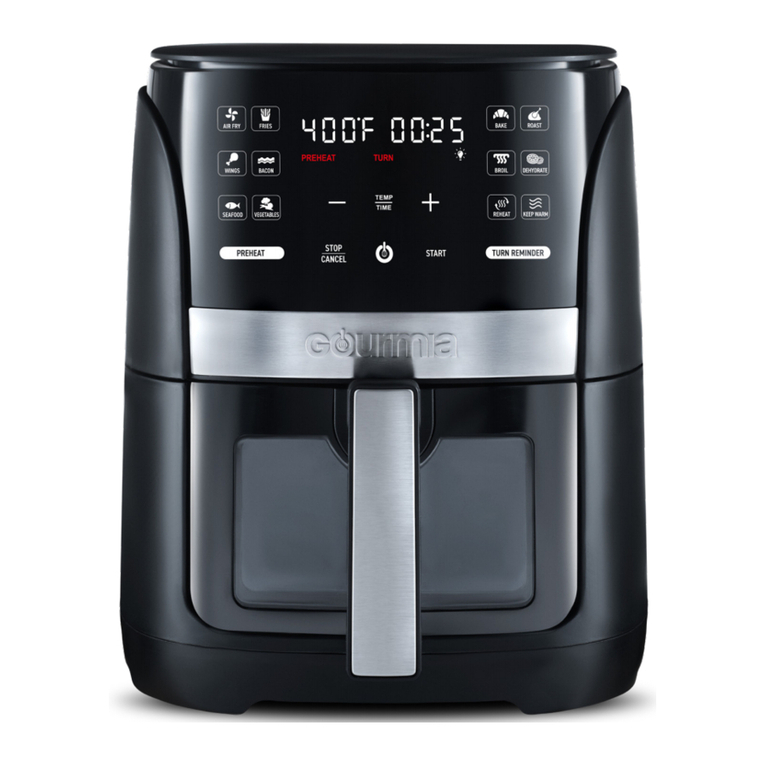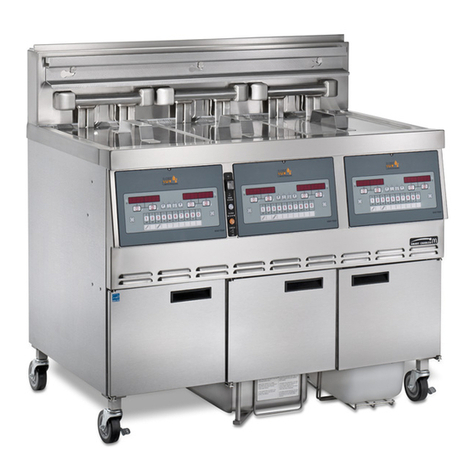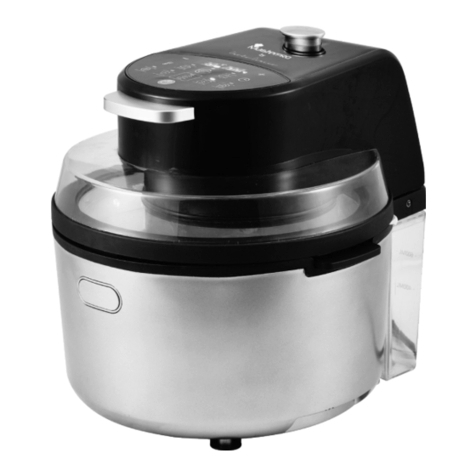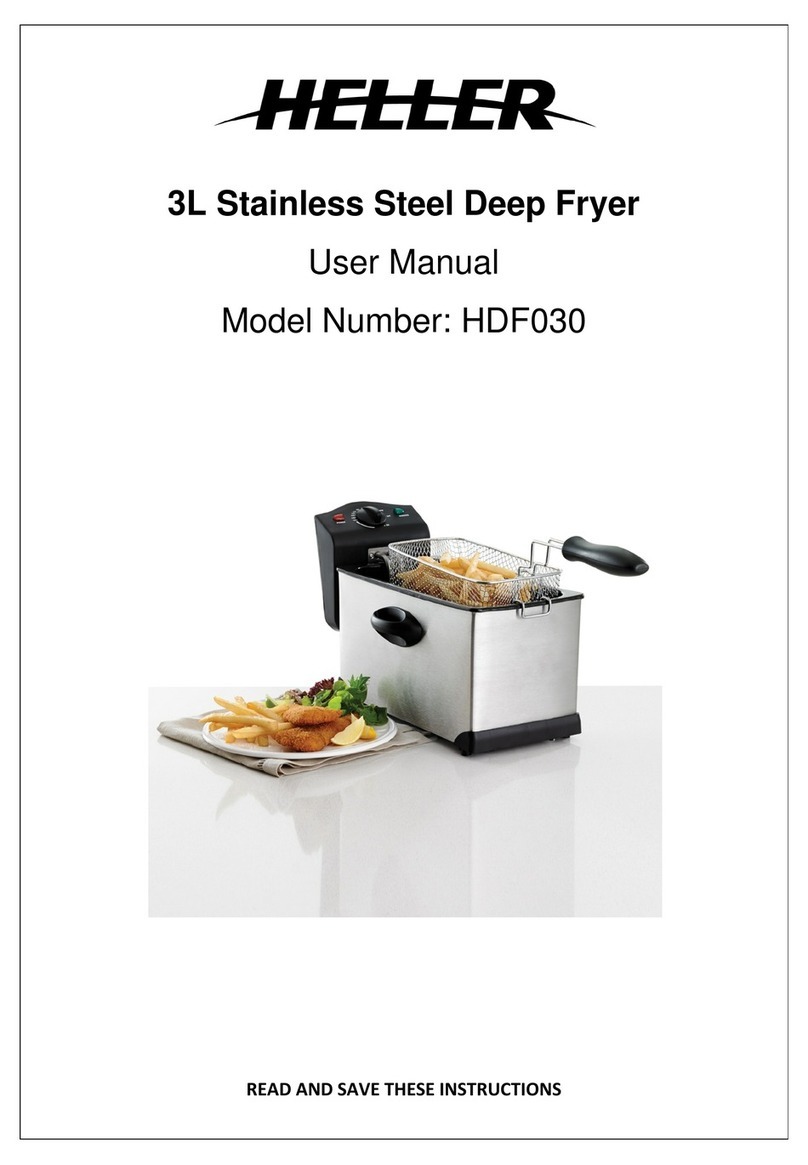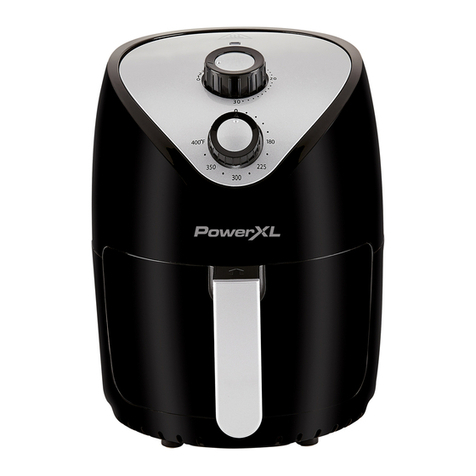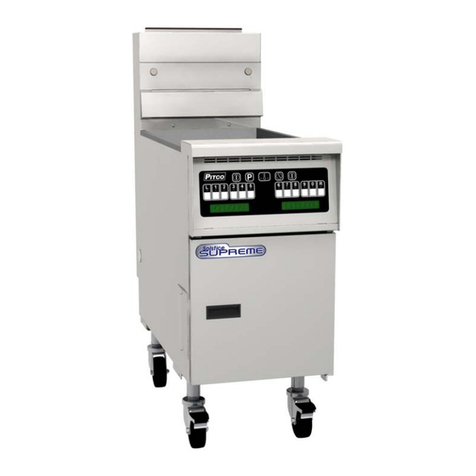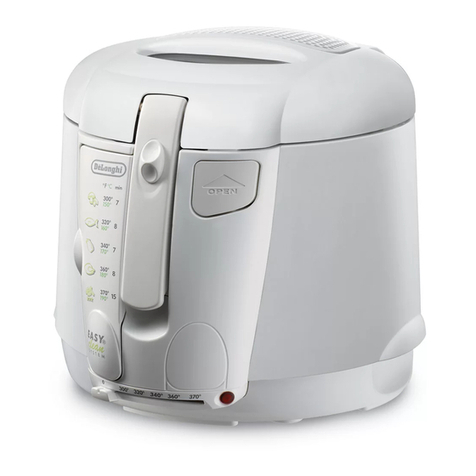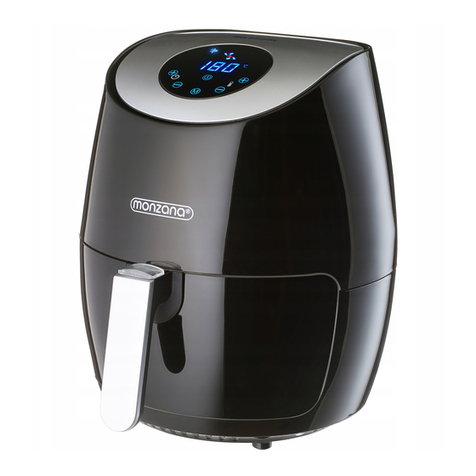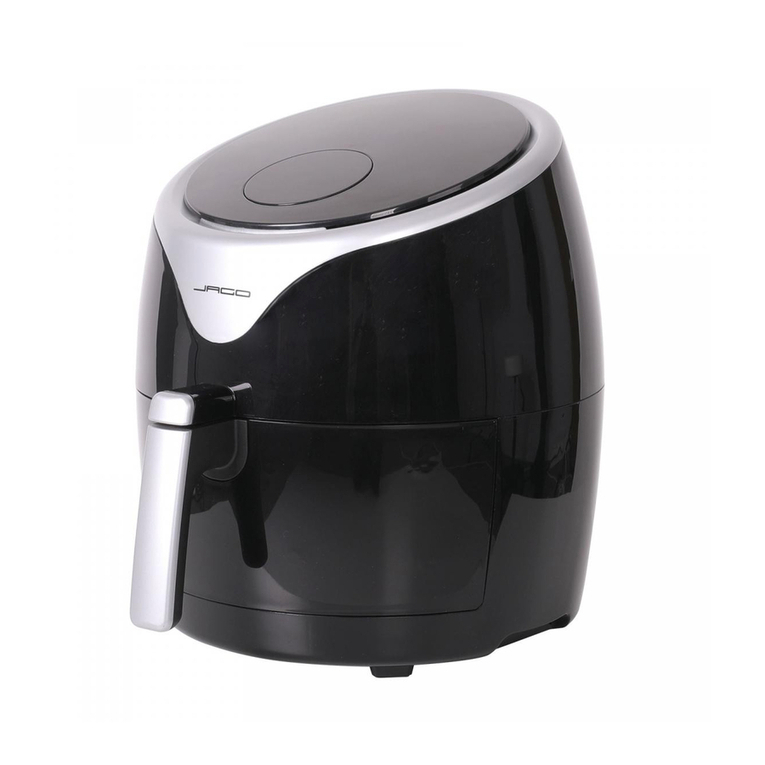Eurofred Minima Series Quick start guide


-2-
ITALIANO ................................................................................................ pagina 2 - 9
ENGLISH ................................................................................................. page 10 - 17
FRANÇAIS ............................................................................................... page 18 - 25
DEUTSCH ................................................................................................ Seite 26 - 33
ESPAÑOL ................................................................................................ página 34 - 42
CAPITOLO DESCRIZIONE PAGINA
INDICE
Avvertenze generali ............................................................................................................................. 3
1. Dati tecnici .......................................................................................................................................... 4
1.1 Friggitrici elettriche serie minima ....................................................................................................... 4
2. Istruzioni per l’installazione ............................................................................................................... 4
2.1 Targhetta piani di cottura elettrici serie minima ................................................................................. 4
2.2 Leggi, norme e direttive tecniche ....................................................................................................... 4
2.3 Collegamento elettrico........................................................................................................................ 5
2.3.1 Messa a terra ........................................................................................................................................ 5
2.3.2 Equipotenziale .................................................................................................................................... 5
2.3.3 Cavo d’alimentazione ......................................................................................................................... 5
2.3.4 Collegamenti alle diverse reti elettriche di distribuzione .................................................................. 6
3. Istruzioni per l’utente .......................................................................................................................... 6
3.1 Accensione friggitrice ......................................................................................................................... 7
3.2 Svuotamento della vasca olio ............................................................................................................. 7
3.3 Limitatore di temperatura .................................................................................................................... 7
3.4 Consigli e accorgimenti ...................................................................................................................... 7
4. Manutenzione e pulizia ...................................................................................................................... 7
SCHEMI DI INSTALLAZIONE ........................................................................................................... 32
SCHEMI ELETTRICI EF46 ................................................................................................................ 33
SCHEMI ELETTRICI EF66 ................................................................................................................ 34

-3-
In caso di inosservanza delle norme contenute nel presente manuale, sia da parte dell’utente che da parte del tecnico
addetto all’installazione, la Ditta declina ogni responsabilità ed ogni eventuale incidente o anomalia causati dalle
suddette inosservanze non potrà essere imputato alla stessa.
La casa costruttrice declina ogni responsabilità per le possibili inesattezze contenute nel presente opuscolo, imputabili ad
errori di trascrizione o stampa. Si riserva inoltre il diritto di apportare al prodotto quelle modifiche che si ritengono utili o
necessarie, senza pregiudicare le caratteristiche essenziali.
- Leggere attentamente le avvertenze contenute nel presente libretto in quanto forniscono importanti indicazioni
riguardanti la sicurezza di installazione, d’uso e di manutenzione.
- Conservare con cura questo libretto per ogni ulteriore consultazione da parte dei vari operatori.
- Dopo aver tolto l'imballaggio assicurarsi dell'integrità dell'apparecchiatura e in caso di dubbio, non utilizzare
l’apparecchiatura e rivolgersi a personale professionalmente qualificato.
- Prima di collegare l’apparecchiatura, accertarsi che i dati riportati sulla targhetta siano corrispondenti a quelli della
rete di distribuzione elettrica.
- L’apparecchiatura deve essere utilizzata solo da persona addestrata all’uso della stessa.
- Per l’eventuale riparazione rivolgersi solamente ad un centro di assistenza tecnica autorizzato dal costruttore e
richiedere l’utilizzo di ricambi originali.
- Il mancato rispetto di quanto sopra può compromettere la sicurezza dell’apparecchiatura.
- Non lavare l’apparecchiatura con getti d’acqua diretti e ad alta pressione.
- Non ostruire le aperture o feritoie di aspirazione o di smaltimento del calore.
- Tutte le apparecchiature sono fornite di cavo, della lunghezza di m. 2, con caratteristiche come specificato in Tab. 2.
AVVERTENZE GENERALI

-4-
1.1 FRIGGITRICI ELETTRICHE SERIE MINIMA
Tab. 1
*TENSIONE DI ALIMENTAZIONE: 3N AC 400 V; 3 AC 230 V; 1N AC 230 V 50/60 Hz.
N.B.: La potenza assorbita con 3N AC 380 V; 3 AC 220 V; 1N AC 220 V 50/60 Hz. è circa del 9% inferiore ai valori riportati.
La potenza assorbita con 3N AC 415 V; 3 AC 240 V; 1N AC 240 V 50/60 Hz. è circa del 9% superiore ai valori riportati.
MODELLO ESTERNO
DIMENSIONI in mm.
L x P x A/A max
EF 46
EF 66
400 x 600 x 270/420
POTENZAASSORBITA*
TOTALE PESO
NETTO
9
9 + 9
kg.
VASCA
Ltr.
12
600 x 600 x 270/420 12 + 12
kw
23
40
1. DATI TECNICI
L’installazione deve essere eseguita da persone qualificate secondo la normativa in vigore.
AVVERTENZE:
Nel caso in cui l’apparecchiatura venga installata contro una parete quest’ultima deve resistere ai valori di temperatura di
100°C e deve essere incombustibile; in caso contrario è indispensabile l’applicazione di un isolante termico.
Prima di procedere all’installazione, togliere dal rivestimento la pellicola di protezione in plastica, eliminando gli eventuali
residui adesivi con prodotto adatto alla pulizia per l’acciaio inossidabile.
Installare l’apparecchio in posizione orizzontale, la corretta posizione si otterrà ruotando i piedini livellatori.
Le varie apparecchiature possono essere installate singolarmente o possono essere accoppiate ad altre apparecchiature della
stessa gamma MINIMA.
Questa apparecchiatura non è idonea per l’incasso.
2.1 TARGHETTA PIANI DI COTTURA ELETTRICI SERIE MINIMA
La targhetta dei dati tecnici si trova sul retro dell’apparecchiatura.
2. ISTRUZIONI PER L’INSTALLAZIONE
2.2 LEGGI, NORME E DIRETTIVE TECNICHE
Per l’installazione sono da osservare le seguenti norme:
- Prescrizioni vigenti antinfortunistiche e antincendio.
- La regolamentazione dell’ente distributore energia elettrica.
- Norme igieniche.
- Norme impianti elettrici.
MBM BRESCELLO - ITALY
RE37187/1998
V
KW
HZ
Matr. N°
Mod.

-5-
2.3 COLLEGAMENTO ELETTRICO
L’allacciamento elettrico deve essere eseguito nel rispetto delle norme CEI, solo da personale autorizzato e competente.
In primo luogo esaminare i dati riportati nella tebella dati tecnici del presente libretto, nella targhetta e nello schema
elettrico. L’allacciamento previsto è del tipo fisso.
IMPORTANTE: A monte di ogni apparecchiatura è necessario prevedere un dispositivo di interruzione omnipolare
della rete, che abbia una distanza di contatti di almeno 3 mm., esempio:
- interruttore manuale di adatta portata, corredato di valvole fusibile
- interruttore automatico con relativi relè magnetotermici.
2.3.1 MESSAA TERRA
E' indispensabile collegare a terra l'apparecchiatura.
A tale proposito è necessario collegare i morsetti, contraddistinti dai simboli ( ) posti sulla morsettiera arrivo
linea, ad una efficace terra, realizzata conformemente alle norme in vigore.
Il costruttore non può essere considerato responsabile per eventuali danni causati dalla mancanza di messa a terra
dell’impianto.
ATTENZIONE: NON INTERROMPERE MAI IL CAVO DITERRA (Giallo-verde)
2.3.2 EQUIPOTENZIALE
L'apparecchiatura deve essere inclusa in un sistema equipotenziale la cui efficienza deve essere verificata secondo le norme
in vigore. La vite contrassegnata con la targhetta «Equipotenziale» si trova sul retro.
2.3.3 CAVO D’ALIMENTAZIONE
L’apparecchiatura viene consegnata predisposta per una delle seguenti tensioni : 3N AC 380...415 V; 2N AC 380...415 V; 3
AC 220...240 V; 1N AC 220...240 V 50/60 Hz.
Il cavo flessibile per l’allacciamento alla linea elettrica deve essere di caratteristiche non inferiori al tipo con isolamento in
gomma H07RN-F. Il cavo deve essere introdotto attraverso il ferma cavo e fissato bene. Inoltre la tensione di alimentazione,
ad apparecchio funzionante, non deve discostarsi dal valore della tensione nominale ± 10%.
L’apparecchiatura è fornita di cavo con caratteristiche come specificato in Tab.2; per accedere alla morsettiera o per sostituirlo,
occorre:
- smontare il pannello frontale
- collegare il cavo d’alimentazione alla morsettiera secondo le necessità, seguendo le indicazioni riportate sull’apposita
etichetta collocata vicino alla morsettiera e nel presente libretto.
MODELLO EF 46 EF 66
TIPO DI TENSIONE
3N AC 380...415 V 50/60 Hz
2N AC 380...415 V 50/60 Hz
3 AC 220...240 V 50/60 Hz
1N AC 220...240 V 50/60 Hz
Max.
A/f
N° cavi
mm2Max.
A/f
N° cavi
mm2
13
26
22,6
39
5 x 1,5
4 x 2,5
4 x 2,5
3 x 4
26
52
45,2
78
5 x 2,5
4 x 10
4 x 6
3 x 10
La targhetta dei tipi di collegamento elettri-
co si trova in prossimità della morsettiera. 123456
380...415 V 3N 50/60 Hz
L1 L2 L3 N PE
L1 L2 N PE
380...415 V 2N 50/60 Hz
220...240 V 3 50/60 Hz
L1 N PE
220...240 V 50/60 Hz
L1 NPE
Tab. 2

-6-
3N AC 380...415 V 50/60 Hz
2N AC 380...415 V 50/60 Hz.
3 AC 220...240 V 50/60 Hz.
1N AC 220...240 V 50/60 Hz.
PE (Terra) giallo-verde
N (NP) azzurro
L3(T) nero
L2(S) nero
L1(R) marrone
PE (Terra) giallo-verde
N (NP) azzurro
L2(S) nero
L1(R) marrone
PE (Terra) giallo-verde
L3(T) azzurro
L2(S) nero
L1(R) marrone
PE (Terra) giallo-verde
N (NP) azzurro
L1(R) marrone
2.3.4 COLLEGAMENTIALLE DIVERSE RETI ELETTRICHE DI DISTRIBUZIONE
Premessa
Prima di mettere in funzione l’apparecchiatura, lavare accuratamente la vasca ed i cestelli, operando come segue:
- Riempire la vasca fino a livello con acqua e detersivo, mettere in funzione il riscaldamento e portare in ebollizione per
alcuni minuti, scaricare l’acqua attraverso il rubinetto di scarico e risciacquare abbondantemente la vasca con acqua
pulita.
-Se per friggere si usa del grasso, non metterlo nella vasca se non è allo stato liquido; dopo l’uso scaricare il grasso
quando è ancora liquido.
- Quando si deve scaldare lo strutto solido, occorre farlo molto lentamente, forando spesso la superficie del grasso per
favorirne la dilatazione e lo scioglimento.
- Durante l’uso si raccomanda di non coprire la vasca o versare all’interno sali o aromi.
- Non mettere mai in funzione l’apparecchiatura prima di aver riempito d’olio il recipiente. La mancata avvertenza di
tale norma arrecherebbe gravi danni per il surriscaldamento della vasca e delle resistenze.
RIEMPIMENTOVASCA
Assicurarsi che il rubinetto di scarico sia chiuso e che la vasca sia pulita, quindi versare l’olio per friggere fino ad un livello
compreso tra la tacca del MIN. e quella del MAX. Per la capacità della vasca vedere la tabella dei dati tecnici 1.1.
ATTENZIONE : il livello dell’olio alla temperatura massima aumenta di circa 1 cm. rispetto al livello a freddo.
RIEMPIMENTO DEL CESTELLO
La quantità di cibo da mettere nel cesto dipende da come si vuole cucinarla. Al momento dell’immersione nell’olio bisogna
evitare un rapido abbassamento della sua temperatura evitando comunque che scenda al di sotto dei 160°C.
Piccoli pezzi di cibo cucinati per il giusto tempo, risultano comunque migliori di un grosso pezzo che deve essere cotto per
più lungo tempo.
3. ISTRUZIONI PER L’UTENTE
Tab. 3

-7-
3.1 ACCENSIONE FRIGGITRICE
Dopo aver riempito la vasca fino ad un livello compreso tra le due tacche:
- Azionare l’interruttore omnipolare a monte dell’apparecchio.
- Accendere l’apparecchio ruotando la manopola (Fig.2) impostando la temperatura desiderata, la spia verde (B) e la spia
gialla (C) sono accese.
- Raggiunta la temperatura impostata, la spia gialla (C) si spegne.
- Se l’apparecchio non viene usato è opportuno che venga spento anche l’interruttore omnipolare.
3.2 SVUOTAMENTO DELLA VASCA OLIO (FIG. 3)
Per effettuare questa operazione bisogna inserire nel rubinetto di scarico l’apposita prolunga (Q), con innesto a baionetta, data
in dotazione. Posizionare un recipiente per il recupero dell’olio ed aprire il rubinetto tirando verso destra la manopolina (U).
Attenzione: è consigliabile che tale operazione venga eseguita con olio freddo.
3.3 LIMITATORE DI TEMPERATURA
Le friggitrici sono dotate di un termostato di sicurezza che interviene in caso di surriscaldamento dell’olio.
Quando questo è intervenuto, per far ripartire l’apparecchio occorre riarmare il termostato. Questa operazione deve essere
effettuata da personale qualificato, che accerterà la causa del suo intervento.
3.4 CONSIGLI EACCORGIMENTI
- Si raccomanda che l’olio o il grasso che vengono usati per la cottura siano di buona qualità e sempre esenti da impurità;queste
debbono essere limitate mediante filtrazione.
- Prima di versare l’olio fresco o filtrato nella vasca accertarsi che questa sia stata pulita a fondo.
- Mettere il coperchio all’apparecchio quando questo non viene usato.
4. MANUTENZIONE E PULIZIA
PARTI INACCIAIO INOSSIDABILE
- Le parti in acciaio inox devono essere pulite con acqua tiepida saponata, quindi risciacquate e poi asciugate con un panno
morbido.
La lucentezza viene mantenuta mediante ripassatura periodica, con POLISH liquido, (un prodotto facilmente reperibile).
- Evitare nel modo più assoluto di pulire l’acciaio inox con paglietta, spazzola o raschietti di acciaio comune, in quanto
possono depositare particelle ferrose che ossidandosi provocano punti di ruggine. Può essere eventualmente adoperata
lana di acciaio inossidabile passata nel senso della satinatura.
- Qualora l’apparecchiatura non venga utilizzata per lunghi periodi, passare energicamente su tutte le superfici in acciaio
un panno appena imbevuto di olio di vaselina, in modo da stendere un velo protettivo. Arieggiare periodicamente i locali.
VASCHE DI COTTURA
Svuotare le vasche dall’olio, togliere il coperchio, cestini e retina alloggiati sopra la resistenze e ruotare le resistenze R
manualmente (Fig. 4).
Con gli elementi riscaldanti in posizione verticale è possibile una totale ed accurata pulizia della vasca.
Attenzione: prima di scaricare l’olio, attendere che sia freddo; i grassi vanno scaricati allo stato liquido.
Pulire periodicamnente il filtro. Si consiglia di usare oli o grassi di buona qualità, esenti da impurità eventualmente
eliminate mediante filtrazione.
Mettere il coperchio quando l’apparecchio non viene usato.

-8-
CHAPTER DESCRIPTION PAGE
INDEX
General remarks ................................................................................................................................... 9
1. Technical data ..................................................................................................................................... 10
1.1 Electric heated deepfat fryers series minima ....................................................................................... 10
2. Installation instructions ...................................................................................................................... 10
2.1 Data plate for electric heated deepfat fryers series minima ................................................................. 10
2.2 Laws, regulations and technical directives ......................................................................................... 10
2.3 Electrical connection .......................................................................................................................... 11
2.3.1 Earthing ............................................................................................................................................... 11
2.3.2 Equipotential....................................................................................................................................... 11
2.3.3 Power supply cable.............................................................................................................................. 11
2.3.4 Connections to various main power supplies ..................................................................................... 12
3. Instructions for the user ....................................................................................................................... 12
3.1 Switching on the fryer ......................................................................................................................... 13
3.2 Draining the oil tank ........................................................................................................................... 13
3.3 Temperature limiter ............................................................................................................................. 13
3.4 Suggestions and advice ....................................................................................................................... 13
4. Maintenance and cleaning .................................................................................................................. 13
INSTALLATION DIAGRAM ............................................................................................................... 32
ELECTRIC DIAGRAMS EF46............................................................................................................ 33
ELECTRIC DIAGRAMS EF66............................................................................................................ 34

-9-
In case of non-compliance with the indications contained in the present manual, both on the user’s part and on the
installing technician’s part, the Manufacturer declines any responsibility, and any possible accident or fault caused by
the above mentioned non-compliances will not be imputable to the Manufacturer.
The Manufacturer declines any responsibility for any imprecisions appearing on the present booklet, ascribable to transcription
or printing errors. Furthermore, the Manufacturer reserves the right to make any modifications to the product deemed useful
or necessary, without prejudicing its essential characteristics.
- Carefully read the instructions contained in the present booklet as they supply important information relating to
safe installation, use and maintenance.
- Keep this booklet with care, for any further consultation by the various operators.
- Having removed the packing, make sure the unit is in good order and in case of doubt, do not use the unit, but call
on skilled personnel.
- Before connecting the unit, make sure the data appearing on the serial plate correspond to those of the main
electric supply.
- The unit must be used only by a person trained for its operation.
- For any repairs, please call exclusively an authorised technical service centre, and ask for original spare parts only.
- Non compliance with the above may compromise the unit’s safety.
- Do not wash the unit with direct or high-pressure water jets.
- Do not obstruct openings or draft grids or heat vents.
- All units are supplied with a 200cm long cable having the characteristics shown in Tab. 2.
- The hook-up wire for the power supply connection should not have characteristics below the type with rubber
insulation H07RN-F.
GENERAL REMARKS

-10-
1.1 ELECTRIC HEATED DEEPFAT FRYERS SERIES MINIMA
EF 46
EF 66
W x D x H/H max.
400 x 600 x 270/420
600 x 600 x 270/420
Ltr.
12
12 + 12
kW
9
9 + 9
ABSORBED ELECTRIC*
POWER NET
WEIGHT
DIMENSIONS IN mm.
ESTERNAL TANK
MODEL
kg.
23
40
*Feeding Power: 3N AC 400V ; 3 AC 230V ; IN AC 230V ; 50/60 HZ
N.B.: the absorbed power with 3N AC 380V ; 3 AC 220V ; 1N AC 220 V 50/60 HZ is around 9% lower than the values supplied.
The absorbed power with 3N AC 415V ; 3 AC 240V ; 1N AC 240V 50/60 HZ is around 9% higher than the values supplied.
1. TECHNICAL DATA
Installation must be performed by qualified technicians according to the law in force.
WARNINGS:
Should the unit be installed against a wall, the latter must be heat-resistant to temperatures of 100°C and must be fireproof;
otherwise, the application of a lagging material shall be absolutely necessary.
Before proceeding with the installation, remove the protective plastic film from the relevant parts, eliminating any adhesive
residues with an appropriate cleaning product suitable for stainless steel.
Install the unit in a horizontal position; its correct levelling will be achieved by rotating the adjustable feet.
The equipment can be separately installed or joined to other equipment belonging to the same range MINIMA.
This equipment is not suitable for embedding.
2.1 DATA PLATE FOR ELECTRIC HEATED DEEPFAT FRYERS SERIES MINIMA
The technical data plate is located on the back of the equipment.
2.2 LAWS, REGULATIONSAND TECHNICAL DIRECTIVES
The following indications should be observed during installation:
- Accident and fire regulations in force
- The regulations of the electric power supply company.
- Hygienic regulations.
- The rules for electrical systems.
2. INSTALLATION INSTRUCTIONS
MBM BRESCELLO - ITALY
RE37187/1998
V
KW
HZ
Matr. N°
Mod.

-11-
2.3 ELECTRICAL CONNECTION
Electrical connection should be performed in compliance with the IEC regulations, only by authorised and competent
personnel. In the first instance, examine the data shown on the technical data table of this manual, on the serial plate and on
the electrical diagram.
The envisaged connection is of the fixed type.
IMPORTANT: Ahead of each unit it is necessary to install an omnipolar main breaker, having a spacing among contacts of
at least 3mm; example:
- manual breaker of appropriate capacity, complete with fuse valves
- automatic breaker with respective magnetothermal relays..
2.3.1 EARTHING
It is essential to earth the unit.
To this purpose, it is necessary to connect to an efficient earthing system the terminals marked with the symbols ( ) placed
on the line-receiving terminal box. The earthing system should comply with the law in force.
The Manufacturer cannot be deemed responsible for any damages caused by the lack of unit earthing.
ATTENTION: NEVER INTERRUPTTHE EARTH WIRE (Yellow-Green).
2.3.2 EQUIPOTENTIAL
The unit should be included within an equipotential system whose efficiency must be tested according to the law in force.
The screw marked with the label “Equipotential” is located on the back.
2.3.3 POWER SUPPLY CABLE
The unit is supplied fitted for the following voltages: 3N AC 380...415V; 2N AC 380...415 V; 3 AC 220...240V; 1N AC
220...240V 50/60 Hz.
The flexible cable for power supply connection should not have characteristics lower than the rubber insulation type
H07RN-F. The cable should be inserted through the cable clamp and firmly fastened. Furthermore, the supply voltage with
the unit functioning should not go outside the value of the nominal tension ±10%.
This equipment is provided with a cable having the characteristics specified in Table 2; to have access to the terminal board
or to replace it, proceed as follows:
- remove the front panel
- connect the cable to the terminal box according to need, and following the instructions shown on the provided label near
the terminal bord and on the present booklet.
MODEL EF 46 EF 66
TYPE OF TENSION
3N AC 380...415 V 50/60 Hz
2N AC 380...415 V 50/60 Hz
3 AC 220...240 V 50/60 Hz
1N AC 220...240 V 50/60 Hz
Max.
A/f
N° cables
mm2
Max.
A/f
N° cables
mm2
13
26
22,6
39
5 x 1,5
4 x 2,5
4 x 2,5
3 x 4
26
52
45,2
78
5 x 2,5
4 x 10
4 x 6
3 x 10
123456
380...415 V 3N 50/60 Hz
L1 L2 L3 N PE
L1 L2 N PE
380...415 V 2N 50/60 Hz
220...240 V 3 50/60 Hz
L1 N PE
220...240 V 50/60 Hz
L1 NPE
The electrical connection plate is placed near
the terminal board.
Tab. 2

-12-
3N AC 380...415 V 50/60 Hz
2N AC 380...415 V 50/60 Hz
3 AC 220...240 V 50/60 Hz
1N AC 220...240 V 50/60 Hz
PE (Ground) yellow-green
N (NP) light blue
L3(T) black
L2(S) black
L1(R) brown
PE (Ground) yellow-green
N (NP) light blue
L2(S) black
L1(R) brown
PE (Ground) yellow-green
N (NP) light blue
L2(S) black
L1(R) brown
PE (Ground) yellow-green
N (NP) light blue
L1(R) brown
2.3.4 CONNECTIONS TO VARIOUS MAIN POWER SUPPLIES
3. INSTRUCTIONS FOR THE USER
Foreword
Before activating the appliance, thoroughly wash the tank and the baskets, operating as follows:
- Fill in the tank to level with water and detergent, activate heating and bring boiling point for a few minutes, drain water
through drainage tap, and thoroughly rinse tank with clean water.
-If you use fat to fry, place it in the tank only in the liquid state: after use, discharge the fat when still liquid.
- When you have to heat up solid lard, you need to do it very slowly, often puncturing the fat surface in order to facilitate
spreading and melting.
- During use, we recommend not to cover the tank nor to introduce salt or spices into it.
-Never activate the appliance before having filled its container with oil. Non compliance with such a provision would
cause serious damage due to overheating of tank and resistors.
FILLING IN THE TANK
Make sure the drain tap is shut off and the tank is clean, then pour frying oil into it to reach the MIN mark, and at any rate
not over the MAX mark. For tank capacity, see technical data Table 1.1.
WARNING: the oil level at the highest temperature increases around 1 cm if compared with the cold level.
FILLING UP THE BASKET
The quantity of food to place into the basket depends on how you wish to cook it. At the moment of immersion in oil, you
need to prevent a too quick lowering of its temperature, avoiding at any rate that it goes under 160°C. Small pieces of food
cooked for the right time, are always better than a big chunk that needs to be cooked for a longer time.
Tab. 2

-13-
3.1 SWITCHING ON THE FRYER
Having filled the tank up to its lower level of MIN:
- Activate the omnipolar switch ahead of the appliance.
- Switch the equipment on by turning handle (see figure 2) and by setting the requested temperature. The green light (B)
and the yellow light (C) are on.
- Having reached the set temperature, the yellow indicator light (C) goes off.
- If the appliance is not used, it is better to turn off the omnipolar switch too.
3.2 DRAININGTHE OIL TANK (FIG. 3)
To perform this operation you need to insert the supplied relevant extension (Q) into the drain tap, with the click-on
connection. Place beneath it a tray for collecting the oil, then open the tap by pulling the knob (U) to the right.
Warning: It is advisable this operation be performed when the oil is cold.
3.3 TEMPERATURE LIMITER
The fryers are fitted with a safety thermostat, which is activated when oil is overheated. Once the thermostat has intervened,
to start the appliance again you need to reset the thermostat. This operation should be carried out by skilled personnel, who
will check the cause of its activation.
3.4 SUGGESTIONSANDADVICE
- We recommend that oil and fat employed for cooking be of good quality and always without impurities: the latter must be
eliminated by filtering.
- Before pouring fresh or filtered oil into the tank, make sure the latter has been thoroughly cleaned.
- Place the lid onto the appliance, when not in use.
STAINLESS STELL PARTS
- Clean the stainless steel parts with soapy lukewarm water, then rinse well and dry thoroughly.
- Brilliance is kept using liquid POLISH periodically, (Polish is a product easy to be found).
- Absolutely avoid to clean the stainless steel with common steel-wool, or common steel brushes and scrapers, as they may
discard ferrous particles which, on depositing, cause rust spots. You may, if you like, use stainless steel-wool passed on
following the butter-finish direction.
- Should the unit remain unused for long periods, heavily rub all the steel surfaces with a cloth slightly wetted with vaseline
oil, in order to cover them with a protective film. Periodically ventilate the premises.
COOKINGTANKS
Drain oil from tanks, remove lid, baskets, and grille housed above the resistor and turn the “R” resistances manually (Fig. 4).
With the heating elements in the vertical position, it is possible to carry out a complete and thorough cleaning of tank.
Warning: before draining the oil, wait for it to become cold; fats must be discharged when in the liquid state.
Clean the filter periodically. We suggest to use good quality oils or fats, with no impurities, which can be eliminated by
filtering if necessary.
Place lid on top when the appliance is not used.
4. MAINTENANCE AND CLEANING

-14-
CHAPITRE DESCRIPTION PAGE
SOMMARIE
Instructions generales.......................................................................................................................... 15
1. Donnees techniques ............................................................................................................................ 16
1.1 Friteuses electriques serie minima ...................................................................................................... 16
2. Instructions pour l’installation............................................................................................................ 16
2.1 Plaquette d’identification des friteuses electriques serie minima ...................................................... 16
2.2 Legislation a respecter ........................................................................................................................ 16
2.3 Branchement electrique ...................................................................................................................... 17
2.3.1 Mise a la terre ...................................................................................................................................... 17
2.3.2 Systeme equipotentiel ......................................................................................................................... 17
2.3.3 Cordon d’alimentation ........................................................................................................................ 17
2.3.4 Branchements au differents reseaux electriques de distribution ........................................................ 18
3. Instructions pour l’utilisateur.............................................................................................................. 18
3.1 Allumage de la friteuse........................................................................................................................ 19
3.2 Vidange du bac d’huile ....................................................................................................................... 19
3.3 Limiteur de temperature ...................................................................................................................... 19
3.4 Conseils et precautions ....................................................................................................................... 19
4. Entretien et nettoyage ......................................................................................................................... 19
SCHEMAS D’INSTALLATION ........................................................................................................... 32
SCHÉMAS ÉLECTRIQUES EF46 ...................................................................................................... 33
SCHÉMAS ÉLECTRIQUES EF66 ...................................................................................................... 34

-15-
En cas de non respect des instructions contenues dans cette notice, aussi bien de la part de l’usager que de l’installateur,
le Fabricant décline toute responsabilité en cas de dégâts à des personnes ou à des biens dérivants de ce non respect.
Le Fabricant décline toute responsabilité sur les conséquences imputables à d’éventuelles inexactitudes dues à des erreurs
de transcription ou d’impression. Le Fabricant se réserve aussi le droit d’apporter toutes les modifications qu’il retiendra
utiles ou nécessaires sur les produits sans en altérer les caractéristiques principales.
- Lisez attentivement les instructions contenues dans cette notice car elles fournissent d’importantes indications
concernant la sécurité d’installation, d’emploi et d’entretien.
- Rangez soigneusement cette notice dans un endroit accessible et adapté à de futures consultations.
- Après avoir déballé l’appareil, contrôlez-en l’intégrité. En cas de doute ne l’utilisez pas et adressez-vous à un
personnel qualifié.
- Avant de brancher l’appareil, assurez-vous que les informations reportées sur la plaquette signalétique correspondent
à celles du réseau de distribution électrique.
- L’appareil ne doit être utilisé que par une personne formée à son usage.
- Pour les réparations adressez-vous seulement à un centre de service après-vente agréé par le Fabricant et exigez
des pièces de rechange d’origine.
- Le non respect de ces indications peut compromettre la sécurité de l’appareil.
- Ne dirigez jamais de jets d’eau à haute pression sur l’appareil pour le laver.
- Tous les appareils sont livrés avec un cordon d’alimentation de 2 m, avec les characteristiques indiquées dans le
Tableau 2.
INSTRUCTIONS GENERALES

-16-
1.1 FRITEUSES ELECTRIQUES SERIE MINIMA
*TENSION D’ALIMENTATION: 3NAC 400V; 3 AC 230V; 1NAC 230V 50/60 Hz
NB: la puissance absorbée avec 3N AC 400V; 3 AC 220V, 1N AC 220V 50/60 Hz est inférieure de 9% environ par rapport
aux valeurs prévues.
La puissance absorbée avec 3N AC 415V; 3 AC 240V, 1N AC 240V 50/60 Hz est supérieure de 9% environ par rapport
aux valeurs prévues.
EF46
EF66
L x P x H/H max.
400 x 600 x 270/420
600 x 600 x 270/420
Ltr.
12
12 + 12
kW
9
9 + 9
PUISSANCE TOTAL*
ABSORBEE POIDS
NET
DIMENSIONS IN mm.
EXTERNE BAC
MODELE
kg.
23
40
1. DONNEES TECHNIQUES
L’installation doit être exécutée par un installateur qualifié en conformité avec la législation en vigueur.
ATTENTION !
Si l’appareil est installé contre un mur, il faut que ce dernier puisse résister à une température de 100° et qu’il soit en matériau
incombustible. Dans le cas contraire, l’application d’un isolant thermique est indispensable.
Enlevez d’abord la pellicule en plastique qui le recouvre et éliminez les résidus éventuels avec un produit de nettoyage
adapté à l’acier inoxydable.
Installez l’appareil horizontalement et contrôlez son horizontalité. Réglez éventuellement en agissant sur les pieds réglables.
Chaque appareil peut être installé isolément ou avec d’autres faisant partie de la même gamme MINIMA.
Cet appareil n’a pas été conçu pour l’encastrement.
2.1 PLAQUETTE D’IDENTIFICATION DES FRITEUSES ELECTRIQUES SERIE MINIMA
La plaquette d’identification est appliquée au dos de l’appareil.
2. INSTRUCTIONS POUR L’INSTALLATION
2.2 LEGISLATIONA RESPECTER
La législation suivante est à respecter :
- Lois sur la prévention des accidents de travail et des risques d’incendie
- Réglementation de la compagnie distributrice d’électricité
- Normes d’hygiène
- Normes sur les “Installations électriques”
MBM BRESCELLO - ITALY
RE37187/1998
V
KW
HZ
Matr. N°
Mod.

-17-
2.3 BRANCHEMENT ELECTRIQUE
Le branchement électrique doit être exécuté dans le respect des normes CEI, par un personnel autorisé et compétent. Avant
tout, vérifiez la correspondance des données reportées dans le tableau des données techniques de ce manuel, sur la plaquette
d’identification et sur le schéma électrique. Le branchement prévu est du type fixe.
IMPORTANT : Prévoyez en amont de chaque appareil, un dispositif d’interruption omnipolaire du réseau qui ait une
distance entre les contacts de 3 mm au moins, par exemple:
- interrupteur manuel de puissance adaptée équipé de fusibles,
- disjoncteur.
2.3.1 MISE A LA TERRE
Il est indispensable de relier l’appareil à une installation de mise à la terre.
Dans ce but, il faut relier les bornes identifiables par le pictogramme ( ) à une installation de mise à la terre efficace, réalisée
conformément à la législation en vigueur.
Le Fabricant décline toute responsabilité en cas de dégâts causés à des personnes ou à des biens provoqués par l’absence
de mise à la terre de l’appareil.
ATTENTION : NE JAMAIS INTERROMPRE LE CABLE DE TERRE (Jaune - vert).
2.3.2 SYSTEME EQUIPOTENTIEL
L’appareil doit être inclus dans un système équipotentiel dont l’efficacité devra être vérifiée conformément à la législation
en vigueur. La vis marquée avec la plaquette “équipotentiel” au dos.
2.3.3 CORDON D’ALIMENTATION
L’appareil est livré prêt à fonctionner à une des tensions suivantes : 3N AC 380 ...415 V; 2N AC 380 ... 415 V;
3 AC 220...240 V; IN AC 220 ... 240 V 50/60 Hz.
Les caractéristiques du câble flexible de branchement à la ligne électrique doivent être au moins égales au câble avec
isolation en caoutchouc H07RN - F. Le câble doit être introduit à travers la bague d’arrêt et fixé correctement. La tension
d’alimentation de l’appareil en marche ne doit pas dépasser la tension nominale de ± 10%.
L’appareil est doté d’un câble dont les caractéristiques sont reportées dans le tableau2. Pour accèder au bornier ou le
remplacer, il faut:
- démonter le panneau de façade
- relier le câble d’alimentation au bornier en fonction des nécessités, suivant les indications reportées sur l’étiquette
appliquée à côté du bornier ou dans ce manuel.
MODELE EF 46 EF 66
TYPE DE TENSION
3N AC 380...415 V 50/60 Hz
2N AC 380...415 V 50/60 Hz
3 AC 220...240 V 50/60 Hz
1N AC 220...240 V 50/60 Hz
Max.
A/f
N° câbles
mm2
Max.
A/f
N° câbles
mm2
13
26
22,6
39
5 x 1,5
4 x 2,5
4 x 2,5
3 x 4
26
52
45,2
78
5 x 2,5
4 x 10
4 x 6
3 x 10
La plaquette des différents branchements
électriques est située près du bornier. 123456
380...415 V 3N 50/60 Hz
L1 L2 L3 N PE
L1 L2 N PE
380...415 V 2N 50/60 Hz
220...240 V 3 50/60 Hz
L1 N PE
220...240 V 50/60 Hz
L1 NPE
Tab. 2

-18-
PE (Terre) jaune-vert
N (NP) blue
L3(T) noir
L2(S) noir
L1(R) marron
PE (Terre) jaune-vert
N (NP) blue
L2(S) noir
L1(R) marron
PE (Terre) jaune-vert
L3(T) blue
L2(S) noir
L1(R) marron
PE (Terre) jaune-vert
N (NP) blue
L1(R) marron
2.3.4 BRANCHEMENTSAU DIFFERENTS RESEAUX ELECTRIQUES DE DISTRIBUTION
3N AC 380...415 V 50/60 Hz
2N AC 380...415 V 50/60 Hz
3 AC 220...240 V 50/60 Hz
1N AC 220...240 V 50/60 Hz
Avant - propos
Avant de mettre en route la friteuse, lavez soigneusement le bac et les paniers en opérant de la façon suivante :
- Remplissez le bac d’eau et de détergent. Mettez en route la friteuse portez à ébullition et laissez bouillir pendant quelques
minutes. Vidangez l’eau à travers le robinet de vidange et rincez abondamment le bac avec de l’eau propre.
- Si vous utilisez de la graisse de friture, versez-la lorsqu’elle est liquide.Après l’usage, vidangez la graisse lorsqu’elle
est encore liquide.
- Faites fondre doucement le saindoux en perçant souvent la surface pour en favoriser la dilatation.
- Pendant l’utilisation, ne couvrez pas le bac et ne versez pas de sel ou d’arômes.
- Ne mettez jamais en route la friteuse avant d’avoir rempli le bac d’huile. Le non respect de cette règle provoquerait
des dégâts irréversibles au fond du bac et aux résistances.
REMPLISSAGE DU BAC
Assurez-vous que le robinet de vidange est fermé. Versez l’huile de friture jusqu’à l’encoche MIN. mais jamais au-dessus de
l’encoche MAX. Reportez-vous au tableau des données techniques (paragraphe 1.1) pour connaître la capacité du bac.
ATTENTION! Le niveau de l’huile à la température maximum augmente de 1 cm environ par rapport au niveau de l’huile froide.
REMPLISSAGE DU PANIER
La quantité d’aliments à introduire dans le panier dépend de leur mode de cuisson. L’important est d’éviter une trop grande
baisse de température au moment de l’immersion. La température de l’huile ne doit jamais descendre en-dessous de 160°C.
La cuisson de petites quantités dans leur juste temps vaut mieux qu’une grosse quantité qui doit cuire pendant plus
longtemps.
3. INSTRUCTIONS POUR L’UTILISATEUR
Tab. 3

-19-
3.1 ALLUMAGE DE LA FRITEUSE
Après avoir rempli le bac jusqu’à l’encoche du niveau minimum :
- actionnez l’interrupteur omnipolaire en amont de la friteuse,
- Allumer l’appareil en tournant la manette (fig. 2) et la placer sur la température désirée. Le voyant vert (B) et le voyant
jaune (C) sont allumés.
- Une fois la température programmée atteinte, le voyant jaune (C) s’éteint.
- Lorsque vous n’utilisez pas la friteuse, il est recommandé de la débrancher.
3.2 VIDANGE DU BAC D’HUILE (FIG. 3)
Introduisez la rallonge (Q) avec prise à baïonette fournie en dotation. Placez un récipient sous le robinet d’une capacité
suffisante pour reccueillir toute l’huile et ouvrez le robinet en tirant la manette (U) vers la droite.
Attention ! Cette opération doit être exécutée lorsque l’huile est froide.
3.3 LIMITEUR DE TEMPERATURE
La friteuse est équipée d’un thermostat de sécurité qui se déclenche en cas de surchauffe de l’huile en arrêtant son
fonctionnement. Pour la faire repartir, il faut réenclencher le thermostat. Cette opération doit être confiée à un personnel
qualifié qui contrôlera aussi la cause du déclenchement.
3.4 CONSEILS ET PRECAUTIONS
- L’huile ou la graisse de friture doivent toujours être de bonne qualité et sans impuretés, en cas de besoin, filtrez-les.
- Avant de verser de l’huile fraîche ou filtrée, vérifiez que le fond du bac est propre.
- Lorsque la friteuse n’est pas utilisée, posez le couvercle dessus.
- Nettoyez les eléments en acier Inox avec de l’eau tiède et savonneuse. Rincez abondamment et séchez soigneusement.
L’éclat est mantenu en utilisant périodiquement du POLISH liquide (un produit facilement trouvable).
- Ne nettoyez jamais les éléments en acier Inox avec des éponges abrasives ou des racleurs en acier car ils abîmeraient la
plaque et provoqueraient, à la longue, son oxydation.
- Avant toute période d’inactivité prolongée, passez un chiffon imbibé d’huile de vaseline sur tous les éléments en acier
Inox, de façon à étaler un film de protection. Aérez périodiquement le local.
BACS DE CUISSON
Videz les bacs d’huile, enlevez le couvercle, les paniers et la petite grille au-dessus de la résistance et tournez manuellement
les résistances «R» (Fig. 4).
En posant les éléments chauffants verticalement, vous pouvez nettoyer à fond le bac.
Attention ! avant de vidanger l’huile, attendez qu’elle soit refroidie. La graisse doit être vidangée lorsqu’elle est liquide.
Nettoyez périodiquement le filtre. Utilisez toujours de l’huile ou de la graisse de bonne qualité et sans impuretés, en cas de
besoin, filtrez-les.
Lorsque la friteuse n’est pas utilisée, posez le couvercle dessus.
4. ENTRETIEN ET NETTOYAGE

-20-
KAPITEL BESCHREIBUNG SEITE
INHALTSVERZEICHNIS
Allgemeine Hinweise .......................................................................................................................... 21
1. Technische Daten ................................................................................................................................ 22
1.1 Elektrisch Beheizte Friteusen Serie Minima....................................................................................... 22
2. Installationsanleitungen ..................................................................................................................... 22
2.1 Datenschild Der Elektrisch Beheizten Friteusen Der Serie Minima ................................................... 22
2.2 Gesetze, Normen Und Technische Richtlinien ...................................................................................22
2.3 Elektroanschluß .................................................................................................................................. 23
2.3.1 Erdleiteranschluß ................................................................................................................................ 23
2.3.2 Äquipotentialsystem ........................................................................................................................... 23
2.3.3 Versorgungskabel ................................................................................................................................ 23
2.3.4 Anschluss An Die Verschiedenen Stromverteilungsnetze ................................................................... 24
3. Anweisungen An Den Verwender ........................................................................................................ 24
3.1 Einschalten Der Friteuse ..................................................................................................................... 25
3.2 Entleeren Der Ölwanne........................................................................................................................ 25
3.3 Temperaturbegrenzer ........................................................................................................................... 25
3.4 Tips Und Nützliche Hinweise ............................................................................................................. 25
4. Wartung Und Reinigung ..................................................................................................................... 25
INSTALLATIONSPLÄNE .................................................................................................................... 32
ELEKTRISHENPLÄNE EF46 ............................................................................................................ 33
ELEKTRISHENPLÄNE EF66 ............................................................................................................. 34
This manual suits for next models
2
Table of contents
Languages:
Other Eurofred Fryer manuals
Popular Fryer manuals by other brands

Team Kalorik
Team Kalorik TKG FT 17 operating instructions

Keating Of Chicago
Keating Of Chicago 14 Counter Specification sheet
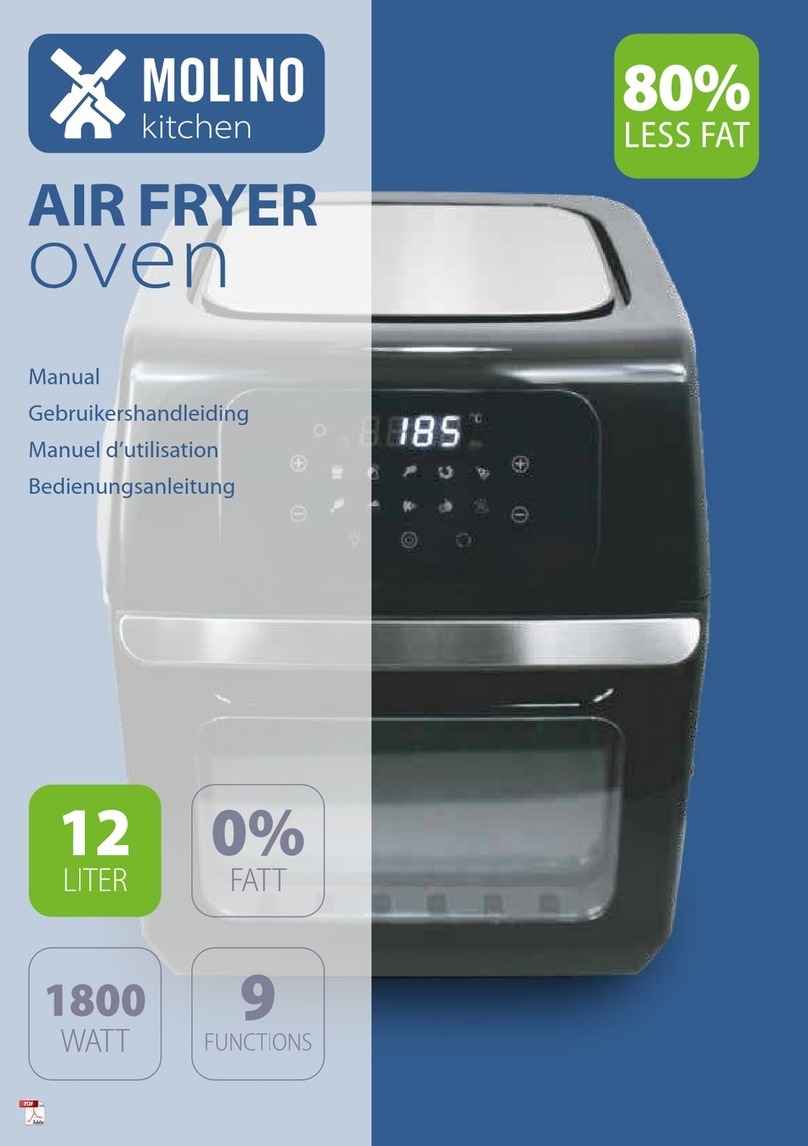
MOLINO
MOLINO B08HNBSMPP manual
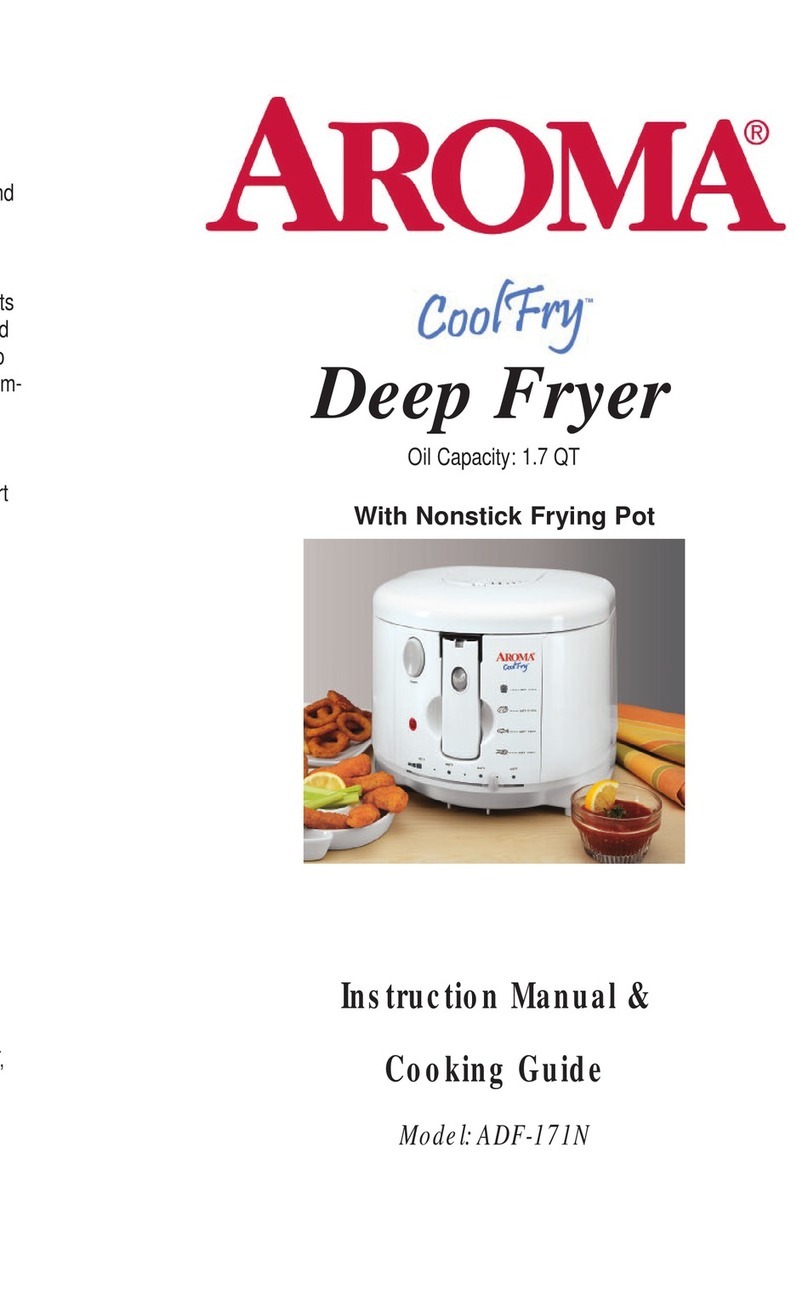
Aroma
Aroma CoolFry ADF-171N Instruction manual & cooking guide

Cosori
Cosori CP137-AF-RXB user manual

Lincat
Lincat Opus 800 Series Installation, operating and servicing instructions

